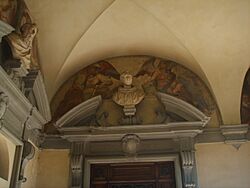Ambrose Traversari facts for kids
Quick facts for kids SaintAmbrose Traversari O.S.B. Cam. |
|
|---|---|

Bust of Traversari in the sacristy cloister of the
Church of St. Mary of the Angels, Florence, Italy |
|
| Scholar, theologian and saint Prior General of the Camaldolese Order |
|
| Born | 1386 Portico di Romagna, Forlì, Papal States |
| Died | 20 October 1439 Florence, Republic of Florence |
| Venerated in | Roman Catholic Church (Camaldolese Order) |
| Feast | 20 November |
Ambrogio Traversari, also known as Ambrose of Camaldoli, was an Italian monk and scholar. He lived from 1386 to 1439. He was a strong supporter of the Pope and the Catholic Church in the 1400s. The Camaldolese Order, a group of monks, honors him as a saint.
Contents
Life Story of Ambrose Traversari
Early Life and Education
Ambrogio Traversari was born in 1386 near a town called Forlì in Italy. When he was just 14 years old, he joined the Camaldolese Order. This was a special group of monks. He went to their monastery in Florence, Italy.
Ambrogio quickly became known as a very smart person. He was a top theologian, someone who studies religious ideas. He was also a great Hellenist, meaning he was an expert in Greek and Greek literature. His teacher for Greek was a famous scholar named Emmanuel Chrysoloras.
Becoming a Leader
For many years, Traversari focused on his studies. But in 1431, he took on a new role. He became the prior general of the Camaldolese Order. This meant he was the main leader of all the Camaldolese monasteries.
Supporting the Pope
Ambrogio Traversari strongly believed that the Pope should have the most power in the Church. He showed this belief clearly at an important meeting called the Council of Basel. He went there as a representative for Pope Eugene IV.
At the council, some people wanted to limit the Pope's power. But Traversari bravely defended the Pope's authority. He said they should not "tear apart Christ's seamless robe," meaning they should not divide the Church.
Later, Pope Eugene sent Traversari to meet with Emperor Sigismund. The Pope wanted the Emperor's help to end the Council of Basel. This council had been trying to take power away from the Pope for five years.
Working for Church Unity
Traversari disliked some of the people at the Basel council. He even called Basel a "western Babylon," comparing it to a place of confusion. Pope Eugene then moved the council to Ferrara in 1437.
Ambrogio continued to support the Pope at the new council in Ferrara. Later, the council moved again to Florence. Traversari worked very hard to bring together the Eastern and Western Churches. These two parts of Christianity had been separated for a long time.
He helped many Greek bishops who were struggling. His efforts led to a special agreement on July 6, 1439. This agreement aimed to unite the two Churches. Traversari was even asked to help write the draft for this important document.
Later Life and Legacy
Ambrose Traversari died soon after this great effort, in October 1439. The Camaldolese Order celebrates his life and work on November 20 each year.
His Character
People saw Ambrose Traversari in different ways. To some of his fellow monks, he seemed strict or even proud. But to his friends who also loved classical studies, like Cosimo de' Medici, he was seen as a brilliant scholar. He was especially interested in ancient Greek writings and religious texts.
His Writings and Translations
Ambrose Traversari was a very productive writer and translator. He wrote about many religious topics. These included a book about the Holy Eucharist and another about the Holy Spirit. He also wrote many stories about the lives of saints. He even wrote a history of his time as the leader of the Camaldolese Order.
He was very important for translating many Greek texts into Latin. This helped spread knowledge in Europe. Some of his famous translations include:
- A life story of John Chrysostom, an important early Christian leader.
- The Ladder of Divine Ascent by John Climacus, a spiritual guide.
- Lives and Opinions of Eminent Philosophers by Diogenes Laërtius. He worked on this between 1424 and 1433. This book became very popular.
- Writings by Manuel Kalekas against the errors of the Greeks. This work is only known because Ambrose translated it.
- Many sermons by John Chrysostom.
- Writings by Dionysius Areopagita (in 1436).
- Basil of Caesarea's book about virginity.
- Thirty-nine talks by Ephrem the Syrian.
- Many other works by early Christian writers from the Greek Church.
Some of his own works that are still known today include:
- Hodoeporicon: This was a diary of his travels to different monasteries in Italy.
- Epistolarium: This was a collection of his letters.
Many of his original handwritten books are kept safe in the library of Saint Mark in Venice, Italy.
See also
- Traversari
- The Baptism of Christ (Piero della Francesca)

